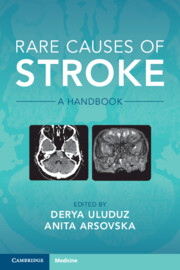Book contents
- Rare Causes of Stroke
- Rare Causes of Stroke
- Copyright page
- Contents
- Contributors
- Preface
- 1 Inflammatory Conditions
- 2 Infectious and Postinfectious Vasculitis
- 3 Hypercoagulable Causes of Stroke
- 4 Drug-Related Stroke
- 5 Hereditary and Genetic Causes of Stroke
- Chapter 5.1 Genetic Collagen Disorders
- Chapter 5.2 Genetic Small-Vessel Diseases
- Chapter 5.3 Genetic Metabolic Diseases
- 6 Rare Causes of Cardioembolism
- 7 Vasospastic Conditions and Other Vasculopathies
- 8 Other Non-inflammatory Vasculopathies
- 9 Venous Occlusive Conditions
- 10 Bone Disorders and Stroke
- Index
- References
Chapter 5.1 - Genetic Collagen Disorders
from 5 - Hereditary and Genetic Causes of Stroke
Published online by Cambridge University Press: 06 October 2022
- Rare Causes of Stroke
- Rare Causes of Stroke
- Copyright page
- Contents
- Contributors
- Preface
- 1 Inflammatory Conditions
- 2 Infectious and Postinfectious Vasculitis
- 3 Hypercoagulable Causes of Stroke
- 4 Drug-Related Stroke
- 5 Hereditary and Genetic Causes of Stroke
- Chapter 5.1 Genetic Collagen Disorders
- Chapter 5.2 Genetic Small-Vessel Diseases
- Chapter 5.3 Genetic Metabolic Diseases
- 6 Rare Causes of Cardioembolism
- 7 Vasospastic Conditions and Other Vasculopathies
- 8 Other Non-inflammatory Vasculopathies
- 9 Venous Occlusive Conditions
- 10 Bone Disorders and Stroke
- Index
- References
Summary
Vascular Ehlers-Danlos syndrome (vEDS) is a genetic disease that has an autosomal dominant pattern of inheritance and is caused by mutations in the COL3A1 gene, resulting in type III collagen synthesis defect, making blood vessels and organs particularly fragile and vulnerable. Vascular complications typically include arterial ruptures but also arterial dissections, which can cause ischaemia in the territory involved; visceral complications are also frequently reported. Patients may show a characteristic facial appearance; joint’s hypermobility and translucent skin with easy bruising are commonly found. Diagnostic criteria have been proposed to improve the diagnosis of this rare disorder, although the genetic confirmation is still required. There is no established treatment, so primary and secondary prevention play a key role in the management of these patients. For example, when a cerebrovascular event, such as a stroke, occurs as a result of a spontaneous dissection of a blood vessel, long-lasting antithrombotic therapy, which is the standard secondary prevention in stroke, is actually contraindicated, considering the high risk of bleeding associated with this disease
Keywords
- Type
- Chapter
- Information
- Rare Causes of StrokeA Handbook, pp. 199 - 205Publisher: Cambridge University PressPrint publication year: 2022

